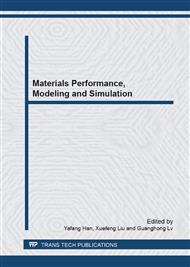[1]
S.H. Kim, D.B. Asay, and M.T. Dugger, Nanotribology and MEMS, Nanotoday. 2 (2007) 22-29.
Google Scholar
[2]
A.S. Christopher, Nanoindentation studies of materials, Materialstoday. 9 (2006) 32-40.
Google Scholar
[3]
A. Gouldstone, N. Chollacoop, M. Dao, J. Li, A.M. Minor, and Y.L. Shen, Indentation across size scales and disciplines: Recent developments in experimentation and modeling, Acta Mater. 55 (2007) 4015-4039.
DOI: 10.1016/j.actamat.2006.08.044
Google Scholar
[4]
E.T. Lilleodden, J.A. Zimmerman, S.M. Foiles, and W.D. Nix, Atomistic simulations of elastic deformation and dislocation nucleation during nanoindentation, J. Mech. Phys. Solids. 51 (2003) 901-920.
DOI: 10.1016/s0022-5096(02)00119-9
Google Scholar
[5]
K.J. Van Vliet, J. Li, T. Zhu, S. Yip, and S. Suresh, Quantifying the early stages of plasticity through nanoscale experiments and simulations, Phys. Rev. B. 67 (2003) 104105.
DOI: 10.1103/physrevb.67.104105
Google Scholar
[6]
D. Saraev, R.E. Miller, Atomic-scale simulations of nanoindentation-induced plasticity in copper crystals with nanometer-sized nickel coatings, Acta Mater. 54 (2006) 33-45.
DOI: 10.1016/j.actamat.2005.08.030
Google Scholar
[7]
A.M. Minor, S.A. Syed Asif, Z.W. Shan, E.A. Stach, E. Cyrankowski, T.J. Wyrobek, and O.L. Warren, A new view of the onset of plasticity during the nanoindentation of aluminium, Nat. Mater. 5 (2006) 697-702.
DOI: 10.1038/nmat1714
Google Scholar
[8]
J. Knap, M. Ortiz, Effect of Indenter-Radius Size on Au(001) Nanoindentation, Phys. Rev. Lett. 90 (2003) 226102.
DOI: 10.1103/physrevlett.90.226102
Google Scholar
[9]
M.R. Shankar, Surface steps lead to heterogeneous contact mechanics and facilitate dislocation nucleation in nanoindentation, Appl. Phys. Lett. 90 (2007) 171924.
DOI: 10.1063/1.2733027
Google Scholar
[10]
E.B. Tadmor, R.E. Miller, Modeling Materials: Continuum, Atomistic and Multiscale Techniques, Cambridge University Press, (2011).
Google Scholar
[11]
E.B. Tadmor, M. Ortiz, and R. Phillips, Quasicontinuum analysis of defects in solids, Philos. Mag. A 73 (1996) 1529-1563.
DOI: 10.1080/01418619608243000
Google Scholar
[12]
E.B. Tadmor, R. Phillips, and M. Ortiz, Mixed Atomistic and Continuum Models of Deformation in Solids, Langmuir 12 (1996) 4529-4534.
DOI: 10.1021/la9508912
Google Scholar
[13]
E.B. Tadmor, R. Miller, and R. Phillips, Nanoindentation and incipient plasticity, J. Mater. Res. 14 (1999) 2233-2250.
DOI: 10.1557/jmr.1999.0300
Google Scholar
[14]
D.B. Shan, L. Yuan, and B. Guo, Multiscale simulation of surface step effects on nanoindentation, Mater. Sci. Eng. A 412 (2005) 264-270.
DOI: 10.1016/j.msea.2005.08.198
Google Scholar
[15]
F. Sansoz, V. Dupont, Grain growth behavior at absolute zero during nanocrystalline metal indentation, Appl. Phys. Lett. 89 (2006) 111901.
DOI: 10.1063/1.2352725
Google Scholar
[16]
V. Dupont, F. Sansoz, Quasicontinuum study of incipient plasticity under nanoscale contact in nanocrystalline aluminum, Acta Mater. 56 (2008) 6013-6026.
DOI: 10.1016/j.actamat.2008.08.014
Google Scholar
[17]
H.T. Wang, Z.D. Qin, Y.S. Ni, and W. Zhang, Multiscale simulation of the deformation in nano-indentation under different crystal orientations, Acta Phys. Sin. 58 (2009) 1057-1063.
DOI: 10.7498/aps.58.1057
Google Scholar
[18]
J.W. Li, J.F. Mei, Y.S. Ni, H.B. Lu, and W.G. Jiang, Two-dimensional quasicontinuum analysis of the strengthening and weakening effect of Cu/Ag interface on nanoindentation, J. Appl. Phys. 108 (2010) 054309.
DOI: 10.1063/1.3452350
Google Scholar
[19]
Y.F. Shao, S.Q. Wang, Quasicontinuum study on formation of fivefold deformation twin in nanocrystalline aluminum, Scripta Mater. 62 (2010) 419-422.
DOI: 10.1016/j.scriptamat.2009.12.005
Google Scholar
[20]
Y.F. Shao, S.Q. Wang, An Examination on Atomic-level Stress Calculations by Nanoindentation Simulation via the Quasicontinuum Method, J. Mater. Sci. Tech. 26 (2010) 56-64.
DOI: 10.1016/s1005-0302(10)60009-6
Google Scholar
[21]
J.W. Li, H.B. Lu, Y.S. Ni, and J.F. Mei, Quasicontinuum study the influence of misfit dislocation interactions on nanoindentation, Comput. Mater. Sci 50 (2011) 3162-3170.
DOI: 10.1016/j.commatsci.2011.05.045
Google Scholar
[22]
H.B. Lu, J.W. Li, and Y.S. Ni, Position effect of cylindrical indenter on nanoindentation into Cu thin film by multiscale analysis, Comput. Mater. Sci 50 (2011) 2987-2992.
DOI: 10.1016/j.commatsci.2011.05.017
Google Scholar
[23]
Y.F. Shao, X. Yang, X. Zhao, and S.Q. Wang, Investigation of grain boundary activity in nanocrystalline Al under an indenter by using a multiscale method, Chin. Phys. B 21 (2012) 083101.
DOI: 10.1088/1674-1056/21/8/083101
Google Scholar
[24]
R.E. Miller, E.B. Tadmor, The Quasicontinuum Method: Overview, applications and current directions, J. Computer-Aided Mater. Design 9 (2002) 203-239.
Google Scholar
[25]
E.B. Tadmor, R.E. Miller, The theory and implementation of the quasicontinuum method, in: S. Yip (Ed. ) Handbook of Materials Modeling, Part A - Methods, Springer-Verlag, New York, (2005).
Google Scholar
[26]
M.S. Daw, M.I. Baskes, Embedded-atom method: Derivation and application to impurities, surfaces, and other defects in metals, Phys. Rev. B 29 (1984) 6443-6453.
DOI: 10.1103/physrevb.29.6443
Google Scholar
[27]
C.L. Kelchner, S.J. Plimpton, and J.C. Hamilton, Dislocation nucleation and defect structure during surface indentation, Phys. Rev. B 58 (1998) 11085-11088.
DOI: 10.1103/physrevb.58.11085
Google Scholar
[28]
A.F. Voter, S.P. Chen, Accurate interatomic potentials for Ni, Al and Ni_3Al, Mater. Res. Soc. Symp. Proc. 82 (1987) 175-180.
Google Scholar
[29]
J. Li, AtomEye: an efficient atomistic configuration viewer, Modeling Simul. Mater. Sci. Eng. 11 (2003) 173-177.
DOI: 10.1088/0965-0393/11/2/305
Google Scholar
[30]
J.D. Honeycutt, H.C. Andersen, Molecular Dynamics Study of Melting and Freezing of Small Lennard-Jones Clusters, J. Phys. Chem. 91 (1987) 4950-4963.
DOI: 10.1021/j100303a014
Google Scholar
[31]
Y.F. Shao, X. Zhao, J.H. Li, S.Q. Wang, submitted to Comput. Mater. Sci. (2012).
Google Scholar


